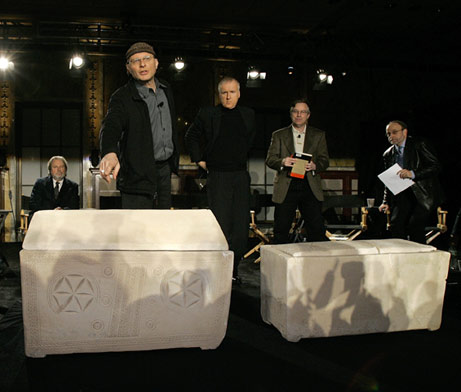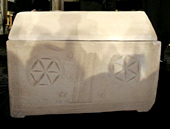The Cave in which Jesus’ buried was found in Israel, Filmmakers Claim
Interesting Stuff, Wonderful Things
Journalist Simcha Jacobovici, left, points to a stone box that he and others say may have once held the remains of Mary Magdalene, beside another that may have held the remains of Jesus of Nazareth, right, during a news conference on February 26, 2007.
Jacobovici directed a film, produced by James Cameron, second from left, that suggests several such boxes found in Israel in 1980 may have contained the bones of Jesus and his family.
A tomb that once held the remains of Jesus of Nazareth—and those of his wife and son—has been found in a suburb of Jerusalem, said the makers of a controversial film in a press conference today.
Click on Read the rest for more controversial stories to unveil its truth …..
The filmmakers base their claims on the study of ten ossuaries—stone boxes used to hold the bones of the dead—that were unearthed at an Israeli construction site in 1980.
Inscriptions on the boxes, in addition to DNA tests of tiny bits of tissue found inside, suggest that the cave was the final resting place of Jesus, his disciple Mary Magdalene, and their son, the filmmakers said.
The claims, if verified, could threaten key tenets of the Christian faith, most notably that Jesus never married or had children and that he was resurrected three days after his death.
“The evidence is compelling,” said Jane Root, president of Discovery Channel, which will air the film on Sunday. “The consequences are enormous.”
The 90-minute film, called The Lost Tomb of Jesus, was directed by journalist Simcha Jacobovici and produced by James Cameron, director of such Hollywood hits as Titanic.
The movie has already sparked criticism from archaeologists and clergy alike.
In a statement issued today, the Reverend Rob Schenck, president of the National Clergy Council, denounced the film’s findings as “nothing more than a modern day circus sideshow.”
“At worst, it is pure chicanery,” he added.
Inscriptions and DNA
Thousands of ossuaries have been found in Jerusalem over the years. Hundreds were uncovered during the building boom the city experienced in the 1980s.
Like many such ceremonial boxes, the ones uncovered in 1980 in the suburb of Talpiot have been dated to 2,000 years ago.
Six of the boxes are inscribed with names of prominent figures from the New Testament, they noted
The inscriptions, written in ancient Aramaic, include “Jesus of son of Joseph;” “Maria,” possibly referring to the mother of Jesus; “Mariamne,” said to be the real name of Mary Magdalene; and “Judah, son of Jesus.”
Scientists at Lakehead University in Ontario, Canada, conducted genetic tests on microscopic bits of material found in the boxes said to belong to Jesus and Mariamne.
Results showed that the two were not related by blood.
Assuming that the cave was devoted to the remains of a single family, in keeping with ancient custom, this finding suggests that Jesus and Mariamne were spouses, the filmmakers said.
“The forensic archaeologist concluded that they were husband and wife,” Jacobovici said.
Skeptics, however, counter that the evidence is too circumstantial to support the film’s contentious claims.
Amos Kloner, the first archaeologist to examine to Talpiot tomb, refutes the film’s theory, saying that the names inscribed on the boxes are not as significant as the filmmakers suggest.
“The names on the caskets are the most common names found among Jews at the time,” Kloner told the Associated Press.
“[Talpiot] was an ordinary, middle-class Jerusalem burial cave,” he added.
Critics might also question the filmmaker’s further suggestion that the cave may be the source of the disputed “James ossuary.”
That ceremonial box sparked controversy in 2003 when its inscription—”James, brother of Jesus—was found to have been faked. (Read “‘Jesus Box’ Is a Fake, Israeli Experts Rule” [June 18, 2003].)
Jacobovici, the film’s director, said further investigation may show that the James ossuary came from the Talpiot cave, which could support his team’s theory that the tomb is that of Jesus’ extended family.
“If that [box] can be traced definitively to this tomb, then there could be no question that this could be the tomb of Jesus of Nazareth and his family,” Jacobovici said. “So the science has to go on.”
